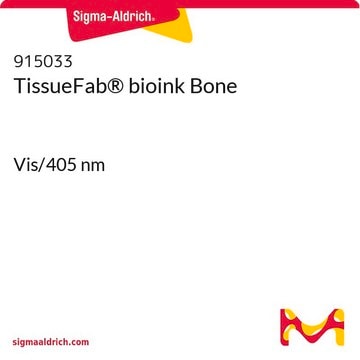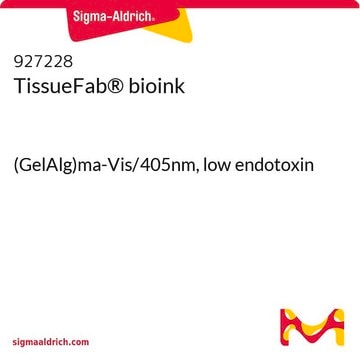920975
TissueFab® bioink
(GelAlgHA)ma -UV/365 nm
Synonyme(s) :
AlgMA, Alginate, Bioink, GelMA, Gelatin, HAMA, Hyaluronic acid
About This Item
Produits recommandés
Niveau de qualité
Description
suitable for 3D bioprinting applications
Stérilité
sterile-filtered
Forme
viscous liquid (or gel)
Impuretés
<5 CFU/g Bioburden (Fungal)
<5 CFU/g Bioburden (Total Aerobic)
Couleur
colorless to pale yellow
Taille des particules
0.2 μm
pH
(6.5-7.5)
Application(s)
3D bioprinting
Température de stockage
2-8°C
Vous recherchez des produits similaires ? Visite Guide de comparaison des produits
Catégories apparentées
Application
This bioink is derived from natural polymers − hyaluronic acid, alginate and gelatin. Hyaluronic acid is also known as sodium hyaluronate or hyaluronan, is an anionic, nonsulfated glycosaminoglycan (GAG). Alginate also known as sodium alginate or alginic acid, is a natural biopolymer obtained from brown algae. Alginate is a natural polysaccharide widely used in tissue engineering. Gelatin contains bioactive peptide sequences similar to native extracellular matrix which promotes integrin mediated cell adhesion and MMP sensitive enzymatic degradation which are essential for cellular functions such as migration, proliferation and differentiation.
Caractéristiques et avantages
- Ready-to-use formulation optimized for high printing fidelity and cell viability, eliminating the lengthy bioink formulation development process
- Step-by-step protocols developed and tested by MilliporeSigma 3D Bioprinting Scientists, no prior 3D bioprinting experience needed
- Suitable for different extrusion-based 3D bioprinter model
Conditionnement
Informations légales
Code de la classe de stockage
10 - Combustible liquids
Classe de danger pour l'eau (WGK)
WGK 3
Certificats d'analyse (COA)
Recherchez un Certificats d'analyse (COA) en saisissant le numéro de lot du produit. Les numéros de lot figurent sur l'étiquette du produit après les mots "Lot" ou "Batch".
Déjà en possession de ce produit ?
Retrouvez la documentation relative aux produits que vous avez récemment achetés dans la Bibliothèque de documents.
Articles
Bioinks enable 3D bioprinting of tissue constructs for drug screening and transplantation; select suitable bioinks for specific tissue engineering.
Learn how 3D bioprinting is revolutionizing drug discovery with highly-controllable cell co-culture, printable biomaterials, and its potential to simulate tissues and organs. This review paper also compares 3D bioprinting to other advanced biomimetic techniques such as organoids and organ chips.
Notre équipe de scientifiques dispose d'une expérience dans tous les secteurs de la recherche, notamment en sciences de la vie, science des matériaux, synthèse chimique, chromatographie, analyse et dans de nombreux autres domaines..
Contacter notre Service technique








